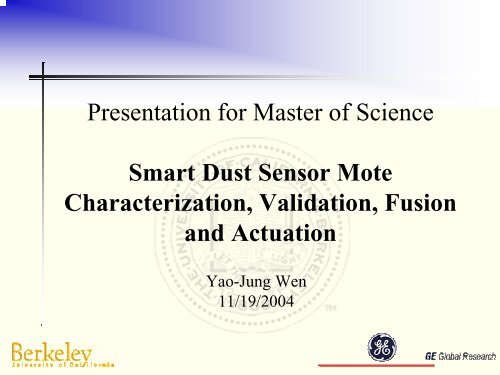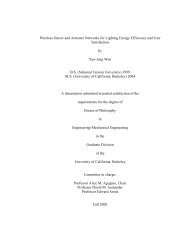Smart Dust Sensor Mote Characterization, Validation, Fusion and ...
Smart Dust Sensor Mote Characterization, Validation, Fusion and ...
Smart Dust Sensor Mote Characterization, Validation, Fusion and ...
Create successful ePaper yourself
Turn your PDF publications into a flip-book with our unique Google optimized e-Paper software.
Presentation for Master of Science<br />
<strong>Smart</strong> <strong>Dust</strong> <strong>Sensor</strong> <strong>Mote</strong><br />
<strong>Characterization</strong>, <strong>Validation</strong>, <strong>Fusion</strong><br />
<strong>and</strong> Actuation<br />
Yao-Jung Wen<br />
11/19/2004
Outline<br />
• Introduction of “Intelligent daylighting control system for<br />
commercial buildings” project<br />
• Introduction of smart dust mote<br />
• <strong>Mote</strong> sensor characterization<br />
– Illuminance characterization<br />
– Temperature characterization<br />
– Accelerometer evaluation<br />
• BESTnet<br />
• <strong>Mote</strong>-FVF: Fuzzy validation <strong>and</strong> fusion for sensor network<br />
• <strong>Mote</strong>-based actuation<br />
• Conclusion<br />
• Future research
Intelligent Daylighting Control<br />
System for Commercial Buildings<br />
• Goal:<br />
– Balancing conflicting lighting preferences of<br />
occupants sharing common lighting switch<br />
– Energy conservation (~50% annual energy saving<br />
by implementing this system)<br />
• <strong>Mote</strong> sensor network in the system<br />
– Perception (illuminance <strong>and</strong> occupancy sensing)<br />
– Actuator (lighting actuation)
<strong>Smart</strong> <strong>Dust</strong> <strong>Mote</strong>s Technology<br />
• <strong>Smart</strong> <strong>Dust</strong> <strong>Mote</strong><br />
– Characteristic<br />
• Capacity of sensing, computation, wireless<br />
communication <strong>and</strong> data storage<br />
• Miniature size, inexpensive, network ready<br />
– Limitation<br />
• Limited energy<br />
• Limited communication range<br />
• Uncalibrated sensors<br />
• Less accurate sensors<br />
• Small sensing scope<br />
• Low robustness to local disturbances
<strong>Mote</strong> <strong>Sensor</strong> <strong>Characterization</strong><br />
• Illuminance characterization • Temperature characterization<br />
1200<br />
1000<br />
Data points<br />
Fitting curve<br />
90<br />
80<br />
70<br />
Illuminance (lux)<br />
Illuminance (lux)<br />
800<br />
600<br />
400<br />
200<br />
0<br />
600 650 700 750 800 850 900 950 1000<br />
Digital Reading<br />
1000<br />
900<br />
800<br />
700<br />
600<br />
500<br />
400<br />
300<br />
200<br />
100<br />
<strong>Sensor</strong>board01<br />
<strong>Sensor</strong>board02<br />
<strong>Sensor</strong>board03<br />
<strong>Sensor</strong>board04<br />
<strong>Sensor</strong>board05<br />
<strong>Sensor</strong>board06<br />
<strong>Sensor</strong>board07<br />
<strong>Sensor</strong>board08<br />
<strong>Sensor</strong>board09<br />
<strong>Sensor</strong>board10<br />
<strong>Sensor</strong>board11<br />
<strong>Sensor</strong>board12<br />
0<br />
600 650 700 750 800 850 900 950 1000 1050<br />
Digital Reading<br />
Temperature residuals ( °C )<br />
Temperature residuals ( °C )<br />
60<br />
50<br />
data1<br />
data2<br />
40<br />
data3<br />
data4<br />
30<br />
data5<br />
20<br />
data6<br />
data7<br />
10<br />
data8<br />
data9<br />
0<br />
data10<br />
data11<br />
-10<br />
0 100 200 300 400 500 600 700 800<br />
<strong>Sensor</strong>Readings<br />
100<br />
Data points<br />
Global mapping curve<br />
80<br />
Xbow's curve<br />
60<br />
40<br />
20<br />
0<br />
-20<br />
0 100 200 300 400 500 600 700 800<br />
<strong>Sensor</strong> readings
<strong>Mote</strong> <strong>Sensor</strong> <strong>Characterization</strong><br />
850<br />
• Accelerometer evaluation<br />
<strong>Sensor</strong> Reading<br />
800<br />
750<br />
700<br />
650<br />
600<br />
550<br />
Chair is empty<br />
mote13 x<br />
mote13 y<br />
mote14 x<br />
mote14 y<br />
Start sitting<br />
in the chair<br />
Sit steady in the chair<br />
Swing the chair<br />
while sitting on it<br />
Leave the chair<br />
500<br />
0 200 400 600 800 1000 1200 1400 1600 1800 2000<br />
Time (sec)<br />
Accelometer Readings<br />
545<br />
540<br />
535<br />
<strong>Sensor</strong> Reading<br />
530<br />
525<br />
520<br />
515<br />
510<br />
600 700 800 900 1000 1100 1200 1300 1400 1500 1600<br />
Time (sec)
BESTnet<br />
• BESTnet v. 1.0<br />
– Centralized single-hop sensor network<br />
– 6 motes in a 3-by-2 matrix under a dimmable lighting fixture<br />
• BESTnet v. 1.1<br />
– Centralized multi-hop sensor network<br />
– 10 motes (6 sensor nodes 4 relay nodes) distributed to 3 desks<br />
• Message packet<br />
Destination address<br />
2 bytes<br />
Active message h<strong>and</strong>ler ID 1 byte Source mote ID 2 bytes<br />
Group ID 1 byte Last sample no. 2 bytes<br />
Message length 1 byte ADC channel 2 bytes<br />
Payload Up to 29 bytes Data array 102bytes
Challenges of <strong>Mote</strong> <strong>Sensor</strong> Networks in<br />
Lighting Application<br />
• <strong>Mote</strong> sensor nodes:<br />
– Small individual sensing scope<br />
– Relatively less accurate sensors<br />
– Low robustness to local disturbances<br />
• <strong>Sensor</strong> networks:<br />
– Massive information<br />
– Data packet collision <strong>and</strong> interference<br />
– Nontrivial to drive a mathematical model<br />
• Lighting environment:<br />
– Highly discontinuous state<br />
– Illuminance variation
How Fuzzy <strong>Validation</strong> <strong>and</strong> <strong>Fusion</strong><br />
Overcome the Challenges?<br />
• Fuzzy logic<br />
– Easy to implement<br />
– No complicated mathematic model involved<br />
– Work well for sensor fusion<br />
• <strong>Sensor</strong> validation <strong>and</strong> fusion<br />
– Isolate faulty sensor data<br />
– Robust to individual local bias<br />
– Boost accuracy<br />
– Extract pertinent local <strong>and</strong> global information
<strong>Mote</strong>-FVF<br />
• <strong>Mote</strong>-FVF (Fuzzy <strong>Validation</strong> <strong>and</strong> <strong>Fusion</strong>)<br />
algorithm<br />
– <strong>Validation</strong><br />
• Majority voting<br />
• Dynamic centered validation curve generating<br />
• Confidence value assigning<br />
– <strong>Fusion</strong><br />
• Weighted averaging<br />
– Prediction<br />
• Exponential weighted moving average time series<br />
predicting
<strong>Mote</strong>-FVF<br />
<strong>Validation</strong><br />
• Fuzzy rules for validation curve:<br />
Def: Cor(x) – the majority voting result<br />
Var(x) – the difference between Cor(x) <strong>and</strong> predicted reading<br />
IF Var(x) small THEN move toward the Cor(x) a small amount<br />
IF Var(x) medium THEN move toward the Cor(x) a medium amount<br />
IF Var(x) large THEN move toward the Cor(x) a large amount<br />
<strong>Sensor</strong> confidence ()<br />
1<br />
0.8<br />
0.6<br />
0.4<br />
0.2<br />
0<br />
x ( ) cor x x ˆx<br />
Fuzzy validation gate<br />
Measurement
<strong>Mote</strong>-FVF<br />
<strong>Fusion</strong><br />
• Weighted average of sensor readings <strong>and</strong> the<br />
predicted value<br />
Def:<br />
x<br />
z<br />
f<br />
− fused value<br />
−<br />
th<br />
i reading from the i sensor<br />
th<br />
( zi<br />
) − confidence value of the i sensor reading<br />
σ<br />
α − adaptive parameter<br />
ω −scaling factor<br />
x<br />
f<br />
=<br />
n<br />
z<br />
i<br />
1<br />
n<br />
∑<br />
∑<br />
1<br />
σ( z)<br />
+ αxˆ<br />
i ω<br />
σ( z ) + α<br />
i ω
<strong>Mote</strong>-FVF<br />
Prediction<br />
• Fuzzy rule for adaptive parameter ( α )<br />
– IF change of readings small THEN α large,<br />
– IF change of readings medium THEN α medium,<br />
– IF change of readings large THEN α small.<br />
• Time series predictor<br />
xˆ( k + 1) = α xˆ( k) + (1 −α<br />
) x ( k)<br />
f
<strong>Mote</strong>-FVF<br />
Implementation<br />
Fused value<br />
True illuminance<br />
<strong>Sensor</strong> data<br />
(one color per node)
Comparison of <strong>Fusion</strong> Algorithms<br />
True illuminance & sensor readings<br />
<strong>Mote</strong>-FVF algorithm (with median<br />
value majority voting approach)<br />
<strong>Mote</strong>-FVF algorithm (with Gaussian<br />
correlation majority voting scheme)<br />
Gaussian correlation majority voting<br />
<strong>Mote</strong>-FVF algorithm without<br />
majority voting
<strong>Mote</strong>-based Actuation<br />
• Hardware setup<br />
– Four 3V power port on prototyping board as 4 digital<br />
output (16 states defined)<br />
– 4 bit digital-to-analog converter<br />
– Current-to-voltage amplifier for D/A converter<br />
• Challenges<br />
– Low actuation state resolution<br />
– Reliability of actuating comm<strong>and</strong><br />
– Nonlinear behavior of dimmable ballast
Conclusion<br />
• <strong>Sensor</strong> aspect<br />
– Photoconductors don’t have linear behaviors<br />
– Accelerometers could be fused with other alternative<br />
occupancy sensors<br />
• <strong>Sensor</strong> validation <strong>and</strong> fusion aspect<br />
– <strong>Mote</strong>-FVF algorithm is capable of extracting pertinent<br />
information <strong>and</strong> rejecting failures<br />
– Simple enough to be embedded in the programmable<br />
motes for intra- <strong>and</strong> inter-network data fusion<br />
– Works for both redundant <strong>and</strong> disparate sensor fusion<br />
• <strong>Mote</strong> actuation aspect<br />
– States of mote actuation could also be fused to boost the<br />
overall efficiency <strong>and</strong> accuracy
Future Research<br />
• Develop method for distinguishing packet loss<br />
from packet delay <strong>and</strong> determine optimal time<br />
between iterations of mote-FVF<br />
• Develop self-calibration algorithm<br />
• Implement mote-FVF with more sensor information<br />
(occupancy sensor, actuation state, etc.)<br />
• Distribute mote-FVF algorithm to motes <strong>and</strong><br />
implement decentralized sensor network<br />
• Derive statistical model, implement <strong>and</strong> compare<br />
mote-FVF with model-based approach.
Majority Voting<br />
(Correlation among <strong>Sensor</strong> Readings)<br />
• Median value approach<br />
– Filter out readings out of the physical limitations of sensor<br />
– Take median of the remaining readings<br />
• Gaussian correlation approach<br />
– Filter out readings out of the physical limitations of sensor<br />
– Generate Gaussian functions centered at each reading<br />
– Take the reading corresponding to the maximum of the<br />
normalized summation of all Gaussian functions
Illuminance-temperature<br />
Interference<br />
illum. (lux) sensor readings mapped temp. true emp. () start time end time<br />
256 start 200.09 24.9 24.4 01:55:50 01:56:15<br />
300 184.75 22.5 24.4 01:56:30 01:57:00<br />
400 167.59 19.6 24.6 01:57:30 01:58:00<br />
500 159.32 18.2 24.8 01:58:50 01:59:20<br />
600 153.49 17.2 25.0 02:00:05 02:00:35<br />
700 147.4 16.2 25.2 02:01:00 02:01:30<br />
800 142.51 15.3 25.4 02:01:55 02:02:25<br />
900 139.61 14.8 25.6 02:03:00 02:03:30<br />
219 217.79 27.6 25.4 02:04:00 02:04:30<br />
900 end 139.7 14.8 25.6 02:04:40 02:05:10<br />
illum. (lux) sensor readings mapped temp. true emp. () start time end time<br />
300 end 192.66 26.7 25.2 02:14:50 02:15:20<br />
261 127.34 15.1 25.2 02:14:10 02:14:40<br />
300 131.76 16.0 25.3 02:13:30 02:14:00<br />
400 135.14 16.7 25.4 02:12:20 02:12:50<br />
500 140.02 17.6 25.5 02:10:35 02:11:05<br />
600 147.91 19.1 25.5 02:09:35 02:10:05<br />
700 156.47 20.7 25.4 02:08:50 02:09:20<br />
800 174.46 23.8 25.4 02:08:10 02:08:35<br />
900 185.79 25.7 25.2 02:07:10 02:07:40<br />
219 start 174.71 23.9 25.1 02:06:25 02:06:55
<strong>Mote</strong>-based Actuation Architecture<br />
Actuating<br />
comm<strong>and</strong><br />
(state)<br />
<strong>Mote</strong><br />
Radio receiver<br />
Prototype board<br />
16 states (levels)<br />
between 0~10V<br />
120V Power<br />
Line<br />
4 bit<br />
digital-to-analog<br />
converter<br />
+5V<br />
Regulator<br />
Transformer<br />
Optional<br />
amplifier<br />
0~10V<br />
-15V<br />
+15V<br />
Regulator<br />
Regulator<br />
Rectifier<br />
Dimmable<br />
ballast
















